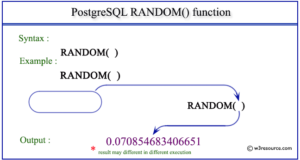REQUEST COMPLIMENTARY SQLS*PLUS LICENCE
PostgreSQL random function

PostgreSQL random function can be used to return a random number or a random number within a range.
Syntax of the random PostgreSQL function
random( )
Parameters and function arguments
- There are no parameters or arguments for the random function.
Note:
- The random function will return a value from 0 (inclusive) to 1 (excluding), so the value will be in the range >= 0 and <1.
- Use the set seed function to set the initial value for random.
- The random function returns a completely random number if no initial number is set (the initial value is set by the set seed function).
- The random function will return a repeatable sequence of random numbers every time a specific initial value is used (the initial value is set using the set seed function).
Random decimal range
To create a random decimal number between two values (range), you can use the following formula:
SELECT random()*(b-a)+a;
Where a is the smallest number, and b is the largest number for which you want to generate a random number.
SELECT random()*(25-10)+10;
The above formula will generate a random decimal number >= 10 and < 25. (Note: this formula will never return 25 because random will never return 1).
Random range of integers
To create a random integer between two values (range), you can use the following formula:
SELECT floor(random()*(b-a+1))+a;
Where a is the smallest number, and b is the largest number for which you want to generate a random number.
SELECT floor(random()*(25-10+1))+10;
The above formula will generate a random integer from 10 to 25 inclusive.
The random function can be used in the following PostgreSQL versions
PostgreSQL 11, PostgreSQL 10, PostgreSQL 9.6, PostgreSQL 9.5, PostgreSQL 9.4, PostgreSQL 9.3, PostgreSQL 9.2, PostgreSQL 9.1, PostgreSQL 9.0, PostgreSQL 8.4.
Example of a random number
Let’s see how to use the random function in PostgreSQL to generate a random number >= 0 and < 1. For example:
SELECT random();
-Result: 0.0186054138466716
Although the random function will return a value above 0, it will never return a value of 1. It will always return a value below 1.
Example of a random decimal range
Let’s see how to use the PostgreSQL random function to generate a random decimal number between two numbers (i.e.: range).
For example, the next one will generate a random decimal value that >= 1 and < 10 (Note: it will never return 10):
SELECT random()*(10-1)+1;
--Result: 1.40731927193701
In the following example, a random decimal value >= 25 and < 40 will be generated (Note: it will never return 40):
SELECT random()*(40-25)+25;
--Result: 33.7993366038427
Example of a random integer range
Let’s see how to use the random function in PostgreSQL to generate a random integer between two numbers (i.e.: including the range).
For example, the next one will generate a random integer value from 1 to 10:
SELECT floor(random()*(10-1+1))+1;
--Result: 6
In the following example, a random integer value between 25 and 40 will be generated:
SELECT floor(random()*(40-25+1))+25;
--Result: 28
PostgreSQL: Generate 1000 Rows
MORE NEWS
PreambleNoSql is not a replacement for SQL databases but is a valid alternative for many situations where standard SQL is not the best approach for...
PreambleMongoDB Conditional operators specify a condition to which the value of the document field shall correspond.Comparison Query Operators $eq...
5 Database management trends impacting database administrationIn the realm of database management systems, moreover half (52%) of your competitors feel...
The data type is defined as the type of data that any column or variable can store in MS SQL Server. What is the data type? When you create any table or...
PreambleMS SQL Server is a client-server architecture. MS SQL Server process starts with the client application sending a query.SQL Server accepts,...
First the basics: what is the master/slave?One database server (“master”) responds and can do anything. A lot of other database servers store copies of all...
PreambleAtom Hopper (based on Apache Abdera) for those who may not know is an open-source project sponsored by Rackspace. Today we will figure out how to...
PreambleMongoDB recently introduced its new aggregation structure. This structure provides a simpler solution for calculating aggregated values rather...
FlexibilityOne of the most advertised features of MongoDB is its flexibility. Flexibility, however, is a double-edged sword. More flexibility means more...
PreambleSQLShell is a cross-platform command-line tool for SQL, similar to psql for PostgreSQL or MySQL command-line tool for MySQL.Why use it?If you...
PreambleWriting an application on top of the framework on top of the driver on top of the database is a bit like a game on the phone: you say “insert...
PreambleOracle Coherence is a distributed cache that is functionally comparable with Memcached. In addition to the basic function of the API cache, it...
PreambleIBM pureXML, a proprietary XML database built on a relational mechanism (designed for puns) that offers both relational ( SQL / XML ) and...
What is PostgreSQL array? In PostgreSQL we can define a column as an array of valid data types. The data type can be built-in, custom or enumerated....
PreambleIf you are a Linux sysadmin or developer, there comes a time when you need to manage an Oracle database that can work in your environment.In this...
PreambleStarting with Microsoft SQL Server 2008, by default, the group of local administrators is no longer added to SQL Server administrators during the...















